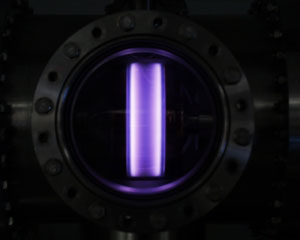| 2003 |

|
YEAR BOOK |
Dublin City University
|
Plasma surface interaction
|

A plasma consists of electrically charged particles, neutral atoms and molecules. A typical way to generate and sustain plasma is to apply an rf generated electric field across two parallel plate electrodes. Free electrons in the gas are accelerated by the applied electric field and collide with gas molecules, ionising the gas, forming a plasma.
The ion bombardment of surfaces plays an essential role in technical applications of gas discharges. Knowledge of the energy distribution of ions hitting the substrate surface is vital for understanding and further developing the techniques used in surface technology processes.
The interface between the bulk plasma and the surfaces it comes into contact with is called the 'sheath'. These sheaths determine important aspects of the plasma-surface interaction. In contrast to the plasma bulk, the sheath region exhibits strong electric fields. Positive ions, created in the plasma bulk, enter into the sheath region and are accelerated towards the electrodes due to these electric fields. The ions gain energy through acceleration by the sheath electric field, and lose energy through collisions in the sheath. Therefore, the impact energy of ions onto the electrode surface is dependent on the sheath characteristics, such as sheath potential, sheath thickness, ion-neutral mean free path, and the ion transit time through the sheath. The shape of the ion energy distribution function at the electrode surface provides crucial information about the formation of ions within the plasma.
In the Plasma Research Laboratory (PRL) at DCU, hydrogen plasmas are investigated using an energy resolved mass spectrometer. This is an important tool in exploring plasma chemistry, and we use it to investigate ion impact at a surface. A detailed computational model of hydrogen plasma chemistry has been developed within PRL, allowing direct comparison with experimental results, thus extending our knowledge of fundamental processes operating within the plasma.
Contact: Deborah O'Connell, Plasma Research Laboratory, School of Physical Sciences, Dublin City University; E-mail: [email protected] ; Web: www.prl.dcu.ie